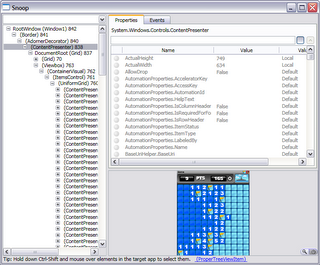Long time since my last post, but don't worry- I haven't been idle.
My latest little project is Snoop, a Spy++ like utility for WPF applications, but cooler.
Documentation
Download

- Browse the visual tree of running WPF applications.
- Inspect properties of elements at runtime.
- Edit properties of elements at runtime.
- Inspect RoutedEvents that are occurring, including the elements that handle them.
- Magnify sections of the UI.
- Find and debug binding errors.
My favorite part of Snoop is that it can even be run on the latest releases of Sparkle- if you're curious how Sparkle is put together, snoop it!
It's essentially a set of utilities that I found useful while developing and debugging Sparkle, the feedback from the rest of the Sparkle developers has been quite positive so I'm hoping other WPF developers will find it useful as well.
Read more ...